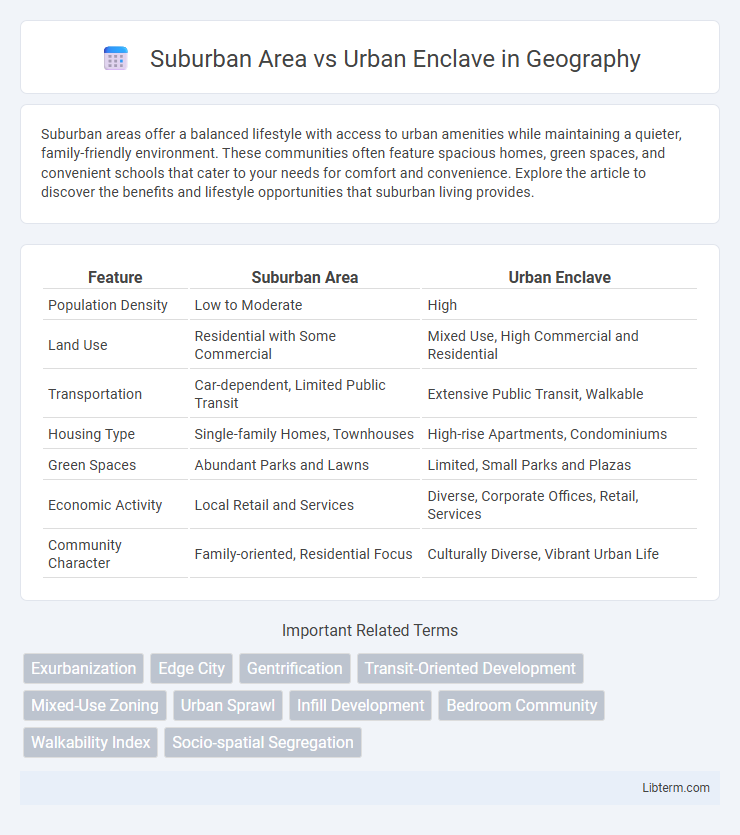Suburban areas offer a balanced lifestyle with access to urban amenities while maintaining a quieter, family-friendly environment. These communities often feature spacious homes, green spaces, and convenient schools that cater to your needs for comfort and convenience. Explore the article to discover the benefits and lifestyle opportunities that suburban living provides.
Table of Comparison
| Feature | Suburban Area | Urban Enclave |
|---|---|---|
| Population Density | Low to Moderate | High |
| Land Use | Residential with Some Commercial | Mixed Use, High Commercial and Residential |
| Transportation | Car-dependent, Limited Public Transit | Extensive Public Transit, Walkable |
| Housing Type | Single-family Homes, Townhouses | High-rise Apartments, Condominiums |
| Green Spaces | Abundant Parks and Lawns | Limited, Small Parks and Plazas |
| Economic Activity | Local Retail and Services | Diverse, Corporate Offices, Retail, Services |
| Community Character | Family-oriented, Residential Focus | Culturally Diverse, Vibrant Urban Life |
Defining Suburban Areas and Urban Enclaves
Suburban areas are residential zones located on the outskirts of a city, characterized by lower population density, single-family homes, and extensive green spaces, often appealing to families seeking more space and quieter environments. Urban enclaves are distinct pockets within a larger city, defined by unique cultural, economic, or social identities, often featuring higher density housing, commercial activities, and a strong sense of community cohesion. The contrast between these lies in their spatial arrangement and lifestyle patterns: suburban areas prioritize spaciousness and separation from urban chaos, while urban enclaves integrate into the city's fabric, highlighting diversity and concentrated cultural expression.
Historical Development Patterns
Suburban areas emerged primarily post-World War II, driven by mass automobile adoption, affordable housing policies, and government investments in highway infrastructure, fostering low-density, car-dependent communities. Urban enclaves developed earlier, characterized by dense populations, mixed land use, and walkable neighborhoods rooted in pre-industrial city planning and immigrant settlement patterns. These contrasting historical development patterns reflect differing social, economic, and transportation influences shaping suburban sprawl versus concentrated urban cores.
Population Density and Demographics
Suburban areas typically exhibit lower population density compared to urban enclaves, with more spread-out residential zones and larger housing units. Urban enclaves often feature higher population density characterized by multi-story apartment buildings and diverse demographic groups, including young professionals and ethnic minorities. Demographically, suburban regions tend to have a higher proportion of families and middle-income households, whereas urban enclaves attract a mix of income levels and cultural backgrounds.
Housing Types and Real Estate Trends
Suburban areas typically feature single-family homes with larger yards, emphasizing spacious living and family-oriented neighborhoods, while urban enclaves often consist of high-density housing such as apartments, lofts, and condominiums catering to professionals and smaller households. Real estate trends in suburban markets show steady growth driven by remote work flexibility and demand for affordable space, whereas urban enclaves experience rising property values fueled by proximity to business districts, cultural amenities, and public transit. Investment in suburban housing leans towards new developments and master-planned communities, contrasting with urban renovations and luxury high-rise constructions in dense city pockets.
Transportation and Connectivity
Suburban areas typically rely on personal vehicles with limited public transportation options, resulting in higher dependency on cars and longer commute times. Urban enclaves offer dense public transit networks, such as buses, subways, and bike-sharing systems, enhancing connectivity and reducing traffic congestion. Efficient transportation infrastructure in urban enclaves supports walkability and access to employment hubs, contrasting with sprawling suburban layouts.
Access to Amenities and Services
Suburban areas typically offer residential neighborhoods with moderate access to amenities such as grocery stores, schools, and parks, often requiring a car for convenient transportation. Urban enclaves provide a high density of amenities and services including restaurants, public transit, healthcare facilities, and cultural institutions within walking distance. The accessibility difference often impacts lifestyle choices, with urban enclaves favoring walkability and convenience while suburban areas emphasize space and quieter environments.
Lifestyle and Community Vibes
Suburban areas typically offer a quieter lifestyle with more space, family-oriented neighborhoods, and access to parks and schools, fostering strong community ties and outdoor activities. Urban enclaves are characterized by a vibrant, fast-paced atmosphere with diverse cultural experiences, close proximity to businesses and entertainment, and a dynamic social scene that promotes networking and innovation. The community vibe in suburban areas emphasizes privacy and homeownership, while urban enclaves thrive on density, walkability, and a mix of residential and commercial spaces.
Economic Opportunities and Employment
Suburban areas typically offer a growing number of economic opportunities driven by the expansion of retail, healthcare, and technology sectors, attracting businesses seeking lower operational costs and access to skilled labor. Urban enclaves provide dense employment hubs with diverse job markets concentrated in finance, creative industries, and professional services, benefiting from proximity to corporate headquarters and infrastructure. Both settings influence employment patterns, with suburbs trending towards commuter-based workforces while urban enclaves maintain high levels of walkability and public transit access for job seekers.
Environmental Impact and Green Spaces
Suburban areas typically feature more extensive green spaces and lower population density, resulting in reduced urban heat island effects and improved air quality compared to urban enclaves. Urban enclaves often suffer from limited green spaces and increased impervious surfaces, contributing to higher stormwater runoff and elevated pollution levels. Effective environmental planning in suburban developments includes preserving natural habitats and integrating parks, while urban enclaves require innovative vertical greening and rooftop gardens to mitigate environmental impacts.
Future Trends in Urban and Suburban Living
Suburban areas are increasingly integrating smart technologies and sustainable infrastructure, promoting eco-friendly living and reducing commute times through improved public transit and remote work options. Urban enclaves are evolving with mixed-use developments that blend residential, commercial, and recreational spaces, fostering vibrant, walkable communities that appeal to diverse demographic groups. Both suburban and urban living trends emphasize resiliency, digital connectivity, and a shift towards green energy solutions to enhance quality of life and address climate change challenges.
Suburban Area Infographic

 libterm.com
libterm.com